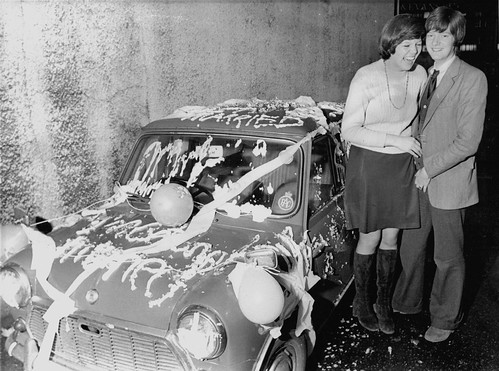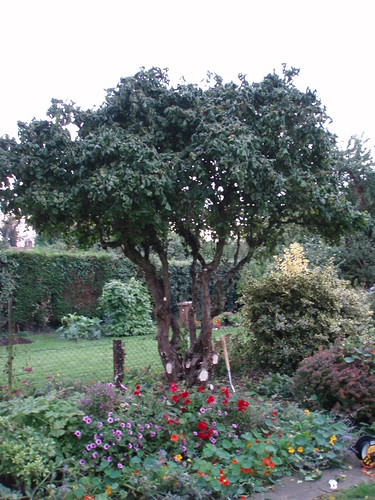Sam and Lucy have been home this weekend. It was a sort of celebration weekend because it’s Lucy’s birthday this week - the Big Three-O - and she also completed her PhD last week.
They came up on Friday night, much to Gravel and Holly’s delight, just as Margaret was going to bed, but their arrival woke her up and it was about 11.30pm when we finally went up (that’s late for us).
Sam is swimming regularly to help him to keep fit and he and Lucy went across to the pool at manor Leisure Centre in Whittlesey the last time they were up for a weekend. This time, I had said I would go too, but it was just Sam and I in the end because Lucy was full of cold. I haven’t been swimming for about 15 years and it felt quite hard work at first. I was too tense and my strokes were not co-ordinated, so that when I got to the end of a length I was feeling quite puffed.
We’d gone to the adult swim session which starts at 9am on Saturday and it wasn’t too busy, so I was able to get my head in gear without anyone getting in my way (or vice-versa). I had to make myself relax, control my breathing and get my head under and glide through the strokes. It soon came back and I was then able to knock off the lengths slowly but surely. I did around 20 lengths, perhaps a couple more, in just over half an hour (including a wee break).
My shoulders certainly felt as if I’d done a workout, but I wasn’t stiff next day. I’d like to try to go regularly, perhaps weekly and get up to 30 or 40 lengths. I’ll see what can be done. I’d also like to try to get in a bike ride at the weekend - Tom and I are planning to go to the TT races again next June and to take cycles onto the ferry so we can get around the island a bit more. It was good last year, but we could only go so far on foot. The trouble with the Isle of Man is that it is quite hilly, so I’ll need to get some toned leg muscles or I’ll never get out of bottom gear. It would also be good to give my bike some regular runs, so I can discover any problems with the old thing before I get there. It’s a Raleigh touring bike, but is about 35 years old. I’ve fitted straight handlebars and a new seat, and it’s had new inner tubes over the years, but apart from that everything is original. Last time I used it, I couldn’t keep it in bottom gear (it might need the gear selector arm adjusting). I’ll definitely need bottom gear on some of those Isle of Man hills!
After swimming, Margaret and I went back to Whittlesey to do the shopping. The past week has been warm, but foggy. We were promised an Indian summer, but what we got was 12 deg C, no wind and four days of fog. On Friday night it rained and then froze and there was a brisk northerly wind (NNW to be precise) which blew away all the fog, but chilled us as well. I had to scrape the windscreen of the car for the first time this winter, although the temperature on my garden thermometer showed a low of 2 deg C and the tender plants such as dahlias and begonias had managed to survive.
It was quite chilly walking round and the town was really busy. It’s flu jab time at the health centre and all the pensioners have been coming to get their jabs on Saturday mornings. The woman in the pet shop asked us if we’d had our jabs yet, which is a bit or a worry because you have to be 65 to get them. Once the health centre car park was full they all came across the road to the shoppers’ car park, so we only just managed to get a place. We’ve been sharing our meat shopping between Jones’ and Freeman & Daughters and this week, it was the turn of Jones. The new people who took it over have done a good job and, although we prefer Freemans’ chickens, I think the beef and sausage is nicer from Jones. In the afternoon Sam and I took the dogs for a walk across the fen. There was no wildlife to be seen, just a few pigeons. Several fields are given over to oilseed rape and that’s coming through quite strongly. I guess Michael Sly has a problem with pigeons because he has a scarecrow in one field and a hawk kite in the other. Neither seems to work as well as a Springer Spaniel and G&H managed a pretty clean sweep of pigeons - we should rent them by the hour.
Other fields have been planted up with winter wheat or barley and that’s also showing much more green than it was a week ago. One of the larger fields has been harrowed and sown in the past week and when Holly ran across it she kicked up so much dirt that her underside was covered. There was no escaping a wash! Sam washed and dried while I held and offered advice. The dogs are very good and will just stand there while they are soaped and rinsed. They do enjoy a rub down with a towel and when they were back in the kitchen, I spent some time brushing them in turn, which they enjoyed greatly. I think they get really itchy as their fur dries and if you let them dry outside, they end up rubbing themselves on a tree trunk and getting covered in algae or rolling about in the borders crushing plants and getting dirty all over again.
Margaret was doing the cooking this weekend, which was nice, and we had my sister round for dinner so she could see Sam and Lucy too. Margaret had made a very impressive pavlova in the morning and dinner was smoked mackerel pate to start, followed by torn roast chicken on roasted vegetables with new potatoes, followed by pavlova with a last hurrah of English raspberries and strawberries. It was jolly nice and washed down with Gifford’s Hall Bacchus from Suffolk and a bottle of champagne.
The clocks went back on Saturday night, so we had an hour later in bed, although Holly and Gravel don’t recognise BST and GMT; they tend to be diurnal or, more likely wake up whenever they hear a noise. I made use of the extra hour to catch the MotoGP races from Phillip Island in Australia. Jorge Lorenzo won the world championship and the race was won by Casey Stoner, the young Australian rider who is retiring this year. Stoner is an exceptional rider, but has never been popular in England despite coming over here to start his career. He’s a typical dour Aussie in the Mick Doohan mould and also committed the heinous crime of beating Valentino Rossi. He won world championships on the Ducati and on a Honda and has been the only man able to ride the Ducati. Tom and I watched him in the rain at Donington Park a few years ago and he was miles quicker than everyone else. They were all wobbling around and falling off, while Stoner had a massive lead but was still going at race pace, sliding the bike and controlling the power out of the bends. It’s one of the best rides I’ve ever seen, absolutely amazing control, but it wasn’t a popular victory. I think he might even have been boo’d on the podium. Well he finished his motorcycle career (at the age of 27) with a comfortable victory. Lorenzo in second, needed only one point to secure the title and wasn’t going to risk a crash by battling with Stoner. MotoGP has been exceptionally dull this year, with a light grid and most races turning into a procession. To try to get more bikes on the grid, they have allowed in cheaper machines powered by production engines and that’s just made it worse, with 10 prototype machines (only four of which are capable of winning) and about the same number of slower bikes, which will only get into the top 10 if the faster bikes crash. World Superbikes, on the other hand, has been brilliant. MotoGPs answer has been not to sort its own championship out, but to buy the Superbike franchise and (one assumes) stop that competing with MotoGP. We might end up with two rubbish championships going forward.
Sam and Lucy were up quite late and then got their noses into giant slalom skiing. Margaret was in charge of cooking again, so I did a few jobs, including some financial bits and bobs. I could really do with a day or so to sort out investments. I’ve got a few that have been really poor performers and I should also take some money out of equities and into cash. The trouble is that cash accounts are offering really poor interest rates, the best you can get is around three per cent and that’s barely keeping pace with inflation. I’ve also got a couple of ISAs where the management charges are far too high. That’s a job for a wet weekend.
Sam and Lucy left mid-afternoon and we were expecting Max back in the evening. He had been competing in the OMM (Original Mountain Marathon) in Cumbria. It’s 26 miles over two days with 3,500 metres of ascent/descent and orienteering as well. You carry all your kit, including tent and sleeping bag.
Max was in a team with Toby Knights, with Andrew and Charlie also competing as a parent and child team. I looked on the website on Sunday morning and Saturday saw Max and Toby were 88th in their category out of around 140. Max got a lift back with Andrew and arrived about 9.30pm. It was odd - Gravel had been very glum when Sam and Lucy went, but about five minutes before Max arrived he went to the patio doors and sat looking out, a couple of minutes later, he wanted to go out and when I opened the back door Max was just coming to the gate. Gravel must have heard Max talking with Andrew down the road as he unloaded his kit. Margaret said earlier that she thought he was going deaf. Nothing wrong with his hearing there.
Max was damp and dirty and his ankles had taken a hammering. He said it had been very hard with some real steep climbs and almost all the route cross-country (only a mile or so on paths). He said it had been cold but clear on Saturday; they’d gone to sleep about 7.30pm, but had been woken up during the night with the rain lashing down. Sunday had been almost entirely cold and wet. Despite all this, he said he was quite keen to do it again and they’d improved their positions to 66th overall, so in the top half of the field.
They came up on Friday night, much to Gravel and Holly’s delight, just as Margaret was going to bed, but their arrival woke her up and it was about 11.30pm when we finally went up (that’s late for us).
Sam is swimming regularly to help him to keep fit and he and Lucy went across to the pool at manor Leisure Centre in Whittlesey the last time they were up for a weekend. This time, I had said I would go too, but it was just Sam and I in the end because Lucy was full of cold. I haven’t been swimming for about 15 years and it felt quite hard work at first. I was too tense and my strokes were not co-ordinated, so that when I got to the end of a length I was feeling quite puffed.
We’d gone to the adult swim session which starts at 9am on Saturday and it wasn’t too busy, so I was able to get my head in gear without anyone getting in my way (or vice-versa). I had to make myself relax, control my breathing and get my head under and glide through the strokes. It soon came back and I was then able to knock off the lengths slowly but surely. I did around 20 lengths, perhaps a couple more, in just over half an hour (including a wee break).
My shoulders certainly felt as if I’d done a workout, but I wasn’t stiff next day. I’d like to try to go regularly, perhaps weekly and get up to 30 or 40 lengths. I’ll see what can be done. I’d also like to try to get in a bike ride at the weekend - Tom and I are planning to go to the TT races again next June and to take cycles onto the ferry so we can get around the island a bit more. It was good last year, but we could only go so far on foot. The trouble with the Isle of Man is that it is quite hilly, so I’ll need to get some toned leg muscles or I’ll never get out of bottom gear. It would also be good to give my bike some regular runs, so I can discover any problems with the old thing before I get there. It’s a Raleigh touring bike, but is about 35 years old. I’ve fitted straight handlebars and a new seat, and it’s had new inner tubes over the years, but apart from that everything is original. Last time I used it, I couldn’t keep it in bottom gear (it might need the gear selector arm adjusting). I’ll definitely need bottom gear on some of those Isle of Man hills!
After swimming, Margaret and I went back to Whittlesey to do the shopping. The past week has been warm, but foggy. We were promised an Indian summer, but what we got was 12 deg C, no wind and four days of fog. On Friday night it rained and then froze and there was a brisk northerly wind (NNW to be precise) which blew away all the fog, but chilled us as well. I had to scrape the windscreen of the car for the first time this winter, although the temperature on my garden thermometer showed a low of 2 deg C and the tender plants such as dahlias and begonias had managed to survive.
It was quite chilly walking round and the town was really busy. It’s flu jab time at the health centre and all the pensioners have been coming to get their jabs on Saturday mornings. The woman in the pet shop asked us if we’d had our jabs yet, which is a bit or a worry because you have to be 65 to get them. Once the health centre car park was full they all came across the road to the shoppers’ car park, so we only just managed to get a place. We’ve been sharing our meat shopping between Jones’ and Freeman & Daughters and this week, it was the turn of Jones. The new people who took it over have done a good job and, although we prefer Freemans’ chickens, I think the beef and sausage is nicer from Jones. In the afternoon Sam and I took the dogs for a walk across the fen. There was no wildlife to be seen, just a few pigeons. Several fields are given over to oilseed rape and that’s coming through quite strongly. I guess Michael Sly has a problem with pigeons because he has a scarecrow in one field and a hawk kite in the other. Neither seems to work as well as a Springer Spaniel and G&H managed a pretty clean sweep of pigeons - we should rent them by the hour.
Other fields have been planted up with winter wheat or barley and that’s also showing much more green than it was a week ago. One of the larger fields has been harrowed and sown in the past week and when Holly ran across it she kicked up so much dirt that her underside was covered. There was no escaping a wash! Sam washed and dried while I held and offered advice. The dogs are very good and will just stand there while they are soaped and rinsed. They do enjoy a rub down with a towel and when they were back in the kitchen, I spent some time brushing them in turn, which they enjoyed greatly. I think they get really itchy as their fur dries and if you let them dry outside, they end up rubbing themselves on a tree trunk and getting covered in algae or rolling about in the borders crushing plants and getting dirty all over again.
Margaret was doing the cooking this weekend, which was nice, and we had my sister round for dinner so she could see Sam and Lucy too. Margaret had made a very impressive pavlova in the morning and dinner was smoked mackerel pate to start, followed by torn roast chicken on roasted vegetables with new potatoes, followed by pavlova with a last hurrah of English raspberries and strawberries. It was jolly nice and washed down with Gifford’s Hall Bacchus from Suffolk and a bottle of champagne.
The clocks went back on Saturday night, so we had an hour later in bed, although Holly and Gravel don’t recognise BST and GMT; they tend to be diurnal or, more likely wake up whenever they hear a noise. I made use of the extra hour to catch the MotoGP races from Phillip Island in Australia. Jorge Lorenzo won the world championship and the race was won by Casey Stoner, the young Australian rider who is retiring this year. Stoner is an exceptional rider, but has never been popular in England despite coming over here to start his career. He’s a typical dour Aussie in the Mick Doohan mould and also committed the heinous crime of beating Valentino Rossi. He won world championships on the Ducati and on a Honda and has been the only man able to ride the Ducati. Tom and I watched him in the rain at Donington Park a few years ago and he was miles quicker than everyone else. They were all wobbling around and falling off, while Stoner had a massive lead but was still going at race pace, sliding the bike and controlling the power out of the bends. It’s one of the best rides I’ve ever seen, absolutely amazing control, but it wasn’t a popular victory. I think he might even have been boo’d on the podium. Well he finished his motorcycle career (at the age of 27) with a comfortable victory. Lorenzo in second, needed only one point to secure the title and wasn’t going to risk a crash by battling with Stoner. MotoGP has been exceptionally dull this year, with a light grid and most races turning into a procession. To try to get more bikes on the grid, they have allowed in cheaper machines powered by production engines and that’s just made it worse, with 10 prototype machines (only four of which are capable of winning) and about the same number of slower bikes, which will only get into the top 10 if the faster bikes crash. World Superbikes, on the other hand, has been brilliant. MotoGPs answer has been not to sort its own championship out, but to buy the Superbike franchise and (one assumes) stop that competing with MotoGP. We might end up with two rubbish championships going forward.
Sam and Lucy were up quite late and then got their noses into giant slalom skiing. Margaret was in charge of cooking again, so I did a few jobs, including some financial bits and bobs. I could really do with a day or so to sort out investments. I’ve got a few that have been really poor performers and I should also take some money out of equities and into cash. The trouble is that cash accounts are offering really poor interest rates, the best you can get is around three per cent and that’s barely keeping pace with inflation. I’ve also got a couple of ISAs where the management charges are far too high. That’s a job for a wet weekend.
Sam and Lucy left mid-afternoon and we were expecting Max back in the evening. He had been competing in the OMM (Original Mountain Marathon) in Cumbria. It’s 26 miles over two days with 3,500 metres of ascent/descent and orienteering as well. You carry all your kit, including tent and sleeping bag.
Max was in a team with Toby Knights, with Andrew and Charlie also competing as a parent and child team. I looked on the website on Sunday morning and Saturday saw Max and Toby were 88th in their category out of around 140. Max got a lift back with Andrew and arrived about 9.30pm. It was odd - Gravel had been very glum when Sam and Lucy went, but about five minutes before Max arrived he went to the patio doors and sat looking out, a couple of minutes later, he wanted to go out and when I opened the back door Max was just coming to the gate. Gravel must have heard Max talking with Andrew down the road as he unloaded his kit. Margaret said earlier that she thought he was going deaf. Nothing wrong with his hearing there.
Max was damp and dirty and his ankles had taken a hammering. He said it had been very hard with some real steep climbs and almost all the route cross-country (only a mile or so on paths). He said it had been cold but clear on Saturday; they’d gone to sleep about 7.30pm, but had been woken up during the night with the rain lashing down. Sunday had been almost entirely cold and wet. Despite all this, he said he was quite keen to do it again and they’d improved their positions to 66th overall, so in the top half of the field.











